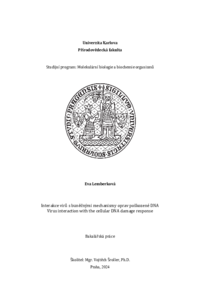Interakce virů s buněčnými mechanismy oprav poškozené DNA
Virus interaction with the cellular DNA damage response
bachelor thesis (DEFENDED)

View/
Permanent link
http://hdl.handle.net/20.500.11956/190190Identifiers
Study Information System: 264072
Collections
- Kvalifikační práce [20088]
Author
Advisor
Referee
Kadlečková, Dominika
Faculty / Institute
Faculty of Science
Discipline
Molecular Biology and Biochemistry of Organisms
Department
Department of Genetics and Microbiology
Date of defense
4. 6. 2024
Publisher
Univerzita Karlova, Přírodovědecká fakultaLanguage
Czech
Grade
Excellent
Keywords (Czech)
odpověď na poškození DNA, homologní rekombinace, nehomologní spojování konců, MRN komplex, Adenoviridae, Papillomaviridae, HerpesviridaeKeywords (English)
DNA damage response, homologous recombination, non-homologous end-joining, MRN complex, Adenoviridae, Papillomaviridae, HerpesviridaePro každou buňku je zásadní zachovávat si integritu své genomové DNA. Integrita genomu je narušována vnějšími a vnitřními vlivy, které působí na buňku a poškozují její genetickou informaci. Porušení struktury nebo sekvence DNA pak zásadně ovlivňují vznikající proteiny nebo správnou segregaci chromozomů do dceřiných buněk, proto je pro buňku důležité je co nejefektivněji opravovat. Existuje mnoho mechanismů oprav DNA pro různé typy poškození. Tato práce se zaměřuje na eukaryotický MRN komplex, který je významný pro detekci a opravu dvouvláknových zlomů DNA. Mnoho čeledí virů se snaží o blokování těchto opravných mechanismů, protože jsou často v buňce aktivovány bezprostředně po infekci virem. Důvodem může být například dvouvláknový DNA genom některých virů připomínající hostitelskou DNA obsahující dvouvláknové zlomy. Buňka tedy zahájením opravných mechanismů virové DNA mnohdy inhibuje životní cyklus viru. Některé viry ale naopak využívají interakcí s jednotlivými komponentami opravných systémů ve vlastní replikaci, a přítomnost těchto proteinů je proto nezbytná k jejich rozmnožení. Klíčová slova: odpověď na poškození DNA, homologní rekombinace, nehomologní spojování konců, MRN komplex, Adenoviridae, Papillomaviridae, Herpesviridae
Maintenance of genomic integrity is an essential mechanism for every cell. Genomic integrity is disturbed by diverse exogenous or endogenous effects influencing the cell and causing damage of its DNA. Cellular mechanisms capable of fixing these disturbances in structure or sequence are indispensable because damaged genetic information can later cause expression of damaged proteins or inaccurate segregation of chromosomes to daughter cells. Therefore, many effective mechanisms for fixing wide range of types of DNA damage have evolved. This thesis focuses mainly on the eucaryotic MRN complex, which plays an important role in detection and repair of double strand breaks. Many viral families try to block these cellular repair mechanisms because they are activated soon after viral infection. One of the reasons for their activation is the resemblance of some viral genomes to the cellular DNA with double strand breaks. Thus, in many cases, the cell ends up inhibiting the life cycle of the virus by attempting to repair viral genomes. However, there are viruses that use cellular repair mechanisms for the replication of their genome, making these mechanisms essential for their own growth. Key words: DNA damage response, homologous recombination, non-homologous end-joining, MRN complex, Adenoviridae,...
